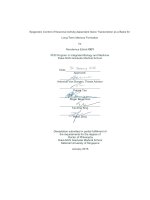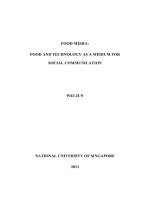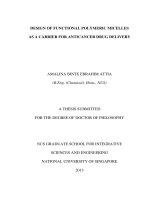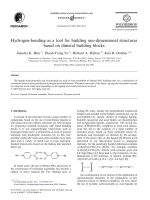Aerial drone as a carrier for miniaturized air sampling systems
Bạn đang xem bản rút gọn của tài liệu. Xem và tải ngay bản đầy đủ của tài liệu tại đây (1.19 MB, 7 trang )
Journal of Chromatography A, 1597 (2019) 202–208
Contents lists available at ScienceDirect
Journal of Chromatography A
journal homepage: www.elsevier.com/locate/chroma
Concept paper
Aerial drone as a carrier for miniaturized air sampling systems
Jose Ruiz-Jimenez, Nicola Zanca, Hangzhen Lan, Matti Jussila, Kari Hartonen,
Marja-Liisa Riekkola ∗
Department of Chemistry and Institute for Atmospheric and Earth System Research, P.O. Box 55, FI-00014, University of Helsinki, Finland
a r t i c l e
i n f o
Article history:
Received 25 January 2019
Received in revised form 3 April 2019
Accepted 6 April 2019
Available online 15 April 2019
Keywords:
Aerial drone
Miniaturized air sampling systems
SPME Arrow
ITEX
Sampler
Sampling accessories
Air sampling
a b s t r a c t
The applicability of an aerial drone as a carrier for new passive and active miniaturized air sampling
systems, including solid phase microextration Arrow (SPME Arrow) and in-tube extraction (ITEX), was
studied in this research. Thermal desorption, gas chromatography and mass spectrometry were used for
the determination of volatile organic compounds (VOCs) collected by the sampling systems. The direct
comparison of the profiles of VOCs, simultaneously sampled in air by SPME Arrow system including four
different coatings, allowed the elucidation of their adsorption selectivity. A more complex experimental
design, involving 20 samples (10 flights) and non-supervised pattern recognition techniques, was needed
for the clarification of the same sampling parameters in the case of five ITEX sorbent materials. In addition, ITEX sampling accessories, such as particle, water and ozone traps, were evaluated by comparing
the results obtained for air samples simultaneously collected by two ITEX systems, packed with the same
sorbent and furnished or not with sampling accessories. The effect of the aerial drone horizontal displacement (HD) on the sampling efficiency was clear in the case of SPME Arrow. The number of detected
compounds and their relative peak area values (RPA) revealed a clear increase (4 and 43%, respectively) in
comparison with samples collected without drone HD. However, just minor differences were observed in
the case of ITEX (2 compounds and 9% of the
RPA). In addition, the system was able to provide almost
simultaneous passive (SPME Arrow) and active (ITEX) samplings at different altitudes (5 and 50 m), being
a good tool for low cost vertical profiling studies ( RPA decreased over 35% for the samples collected at
50 m). Finally, the successful simultaneous air sampling by SPME Arrow and ITEX systems in two difficult
access places, such as boreal forest and wetlands, was demonstrated, resulting in 21 and 31 detected
compounds in forest and wetlands by SPME Arrow, and 27 and 39 compounds by ITEX.
© 2019 The Authors. Published by Elsevier B.V. This is an open access article under the CC BY license
( />
1. Introduction
Aerial drones, also called unmanned aerial vehicles, remotely
piloted aircraft systems or simply drones, have become very popular over the last decade [1]. The original military use of these devices
has expanded to civil and scientific applications [2]. Among others, aerial drones can be used as carriers for air sampling systems,
analyzers and sensors, replacing or complementing the traditional
ways to sampling at high altitudes such as airships, aircrafts, tethered balloons and meteorological towers [3–6].
Aerial drones can be classified into two different categories
according with their design: fixed wing, mainly used for sampling
over long distances, and; rotary-wing, used on localized studies
[7,8]. The later has clear advantages in terms of maneuverabil-
∗ Corresponding author.
E-mail address: marja-liisa.riekkola@helsinki.fi (M.-L. Riekkola).
ity, cost and cleanness. The use of electrically powered engines
limits the potential contamination sources [8]. The effect of the
number of rotors on the aerial drone payload capacity, in-flight
stability and maneuverability have been widely described in the
literature without clear conclusions. Old aerial drone models show
a clear improvement of flight performance with the number of
rotors [9]. However, the opposite trend was observed for new aerial
drone models furnished with a relative low number of rotors. More
clear conclusions were drawn from the design of rotary-wing aerial
drones. The use of multiple rotors at the periphery, equidistant
around a central core, allows the allocation of sensors and sampling systems on the center of the craft, far away from potential
turbulences and interferences [10].
A wide variety of sensors have been attached to aerial drones
to provide continuous monitoring of different parameters such
as temperature, humidity, pressure, black carbon, CO2 , CO, NO2 ,
NO, the number of particles, particle size distribution or even
total volatile organic compounds (VOC) concentration [8,9,11].
/>0021-9673/© 2019 The Authors. Published by Elsevier B.V. This is an open access article under the CC BY license ( />
J. Ruiz-Jimenez et al. / J. Chromatogr. A 1597 (2019) 202–208
However, the use Tedlar bags, stainless steel canisters and a wide
variety of active sampling systems including filters, adsorption
tubes is still mandatory for the analysis of individual compounds
in the samples [8,12–14]. In addition, to our best knowledge, SPME
Arrow systems have never been used for the collection of air in
combination with aerial drones.
Solid phase microextraction (SPME) have been widely used in
extraction of different sample matrices and also as air sampling
systems. Despite its popularity, some drawbacks related with the
SPME fibers such as, easy breakage, limited lifetime, restricted coating thickness, limited sorption capacity and instability have been
observed. Different microextraction techniques, including SPME
Arrow and ITEX, have been developed in order to overcome these
problems and to improve sampling performance [15–17].
SPME Arrow consists of a steel rod coated with a larger volume
of extraction sorbent than traditional SPME fibers. The use of high
sorbent volumes improves the detection limits. The design of the
SPME Arrow device with the arrow-shaped tip is compatible with
the GC injector port with some minor modifications. Furthermore,
design of this device protects the sorbent, minimizing unfavorable
influences and loss of analytes during desorption [15–20].
In-tube extraction (ITEX) system was developed to provide high
performance. It was designed as a two-part stainless steel needle
attached to a pumping system. The lower part consists of a conical tip needle with the side hole for septum penetration. The upper
part is the larger diameter tube filled with a sorbent material, allowing higher amount of extraction sorbent in comparison with other
approaches such as needle trap devices (NTD). However, unlike
SPME Arrow, NTD and ITEX need a pump for the collection of the
analytes on the sorbent and an external heater to facilitate thermal
desorption to the GC system [17,21].
The potential applicability of an aerial drone as a carrier for new
miniaturized air sampling systems, such as SPME Arrow and ITEX,
was evaluated in this research. The use of these sampling techniques could overcome problems found in traditional sampling
techniques such as SPME fiber or thermal desorption tube (TDT).
In addition, this is the first time when a SPME Arrow was used in
combination with aerial drone. Different experimental approaches
and configurations, based on simultaneous collection of air samples
were developed for the characterization of the sampling systems
and the evaluation of the sampler performance. The effect of horizontal and vertical displacements of the drone during the sampling
was also evaluated. The latter will allow the almost simultaneous
air sampling at different altitudes, making possible the development of low-cost vertical profile studies. Finally, an aerial drone,
furnished with both, ITEX and SPME Arrow sampling systems, was
used for the simultaneous collection of air samples in two difficult
access places, such as boreal forest and wetland.
203
ultrapure water (DirectQ-UV, Millipore Corp., Billerica, USA) were
used for ozone trap coating. Finally, magnesium perchlorate from
Aldrich (Steinheim, Germany) and deactivated glass wool were
used for water trap preparation
Altogether seven ITEX and six SPME Arrows were used for
air sampling. In detail: three ITEX packed with 50 mg of three
lab-made polyacrylonitrile (PAN) nanofibers (10% PAN, 8.75%
PAN, 5% PAN), two commercial Tenax GR and two commercial Tenax TA (CTC Analytics AG, Zwingen, Switzerland) [22].
Two SPME Arrows coated with carbon (Carbon wide range (WR)
and Carbon WR/Poly(dimethylsiloxane) (PDMS)), two with polymeric (PDMS/Divinylbenzene (DVB)) (CTC Analytics AG, Zwingen,
Switzerland) and two with self-made functionalized mesoporous
silica materials (MCM-41-Ti) [23].
2.2. Sampling device
Air samples were collected by a sampler, consisting of a remote
controlled drone Geodrone X4L, with dimensions 58 × 58 x 37 cm
and a total weight of 2 kg, (Videodrone, Finland) furnished with
a drone box, which allows the simultaneous sampling on multiple ITEX and SPME Arrow systems. Detailed scheme and pictures
of aerial drone-based SPME sampler can be seen in Fig. 1. Additional information of the aerial drone can be found from electronic
supplementary information (ESI-1). Drone box device involved a
3 G remote-controlled circuit, two SPME Arrow holders with opening/closing system, two on/off valves for gas flow control and tubes
for ITEX connections with sampling pump. The total weight of
drone box including the pump was about 1.4 kg, which allowed
a total flight time close to 35 min. The smartphone app Juice SSH
mobile had the access to the operating system Raspbian to control
the hardware Raspberry Pi (Raspberry Pi Foundation) in the drone
box. The system was used via the 3 G modem (Huawei) to control
the ITEX pump, valves, SPME holders and to their opening/closing
system.
2.3. Instruments
An Agilent 6890 N gas chromatograph (Agilent Technologies,
Pittsburg, PA, USA), equipped with a split/splitless injector and a
lab-made ITEX heater for thermal desorption, was coupled to an
Agilent 5973 mass spectrometer for the separation and detection
of VOCs present in the air samples. The chromatograph was furnished with a GC Sciences (Eindhoven, The Netherlands) InertCap
for Amines (30 m x 0.25 mm i.d., no information was provided for
the film thickness) fused silica column coupled with a 3-m deactivated retention gap (i.d. 0.53 mm, Agilent). Additional information
about the gas chromatographic analysis, including sample storage,
thermal desorption conditions, GC oven temperature program and
SPME Arrow and ITEX preconditioning, can be found in ESI-2.
2. Experimental
2.4. Measurement sites
2.1. Materials
Decafluorobiphenyl (99.99%, Fisher Chemical) was used as
internal standard (IS). The stock standard solution was prepared
dissolving 0.1 g of IS in 100 mL of methanol. Standard working solution (1 g/mL) was prepared by subsequent dilution in methanol.
Liquid and gas phase solutions were used for ITEX and SPME Arrow
including IS addition, respectively. Diffusion vials were prepared by
addition of 1 L IS working solution to a 20 mL pre-heated (40 ◦ C)
vial.
A 0.45 m Nylon filter from Nalgene (Rochester, NY, USA)
was used as aerosol particles trap. Potassium iodine from Merck
(Darmstadt, Germany), glycerol from Sigma–Aldrich (St. Louis, MO,
USA), methanol from J.T. Baker (Deventer, The Netherlands) and
The applicability of aerial drone as a carrier for miniaturized
air sampling systems was evaluated from the 22nd to 26th of
October 2018 at the SMEAR II station (Station For Measuring
Ecosystem–Atmosphere Relations), Hyytiälä. The soccer field area
(61.844400 ◦ N - 24.287033 ◦ E) was selected as test field due to good
visible conditions and the scarce number of obstacles in the zone
[24]. In addition, 8 samples were collected on difficult access places,
such as the forest nearby next to the SMEAR II tower (61.846350 ◦ N
- 24.295333 ◦ E – 23 October 2018) and Siikaneva wetland area (26
October 2018). The latter was located in Ruovesi (61.833266 ◦ N,
24.192550 ◦ E), 8 km from SMEAR II station, a well-known site for
carbon and energy studies and soil processes [25]. In both cases,
two ITEX and two SPME Arrows, the first without any sampling
204
J. Ruiz-Jimenez et al. / J. Chromatogr. A 1597 (2019) 202–208
Fig. 1. Aerial drone as a carrier for new miniaturized air sampling systems (A) Front schematic view and pictures from details (B) Side schematic view and pictures from
details.
accessories, were simultaneously sampled during a single flight.
Control valves and SPME Arrow actuators were in close position up
to when aerial drone was placed in the sampling position, avoiding
the sampling while the drone was moving.
2.5. Adsorption selectivity studies
The versatility of aerial drone-based SPME sampler allowed the
evaluation of the sorbent selectivity of both passive and active
sampling by using two different approaches. The first approach,
included four SPME Arrows with Carbon WR, Carbon WR/PDMS,
PDMS/DVB and MCM-41-Ti coatings, was based on the simultaneous collection of multiple samples during a single flight (30 min at
5 m), followed by the analysis of the samples and the direct comparison of the results. The second approach, included five ITEXs with
Tenax GR, Tenax TA, PAN 5%, PAN 8.75% and PAN 10% sorbents, was
more demanding due to the pump needed for active air sampling,
limiting the number of simultaneous ITEX system to two during
each flight. An experimental design comprising 10 flights within
three days, VOC analysis and statistical evaluation of the results
were then developed. Additional information about the sampling
procedures and the experimental design is found from ESI-3.
placement (VD) on the samples collected by two ITEXs with Tenax
TA sorbent and two SPME Arrow systems with MCM-41-Ti coating was evaluated during a single flight by alternative sampling at
different altitudes. No sampling accessories were used in the case
of ITEX. In both cases, simultaneous sampling was developed for
SPME Arrow and ITEX systems. A detailed description of the flying
programs for HD and VD is seen in ESI-4.
2.8. Data handling and statistical analysis
ADAP-GC (Automated Data Analysis Pipeline) for pre-processing
untargeted mass spectrometry-based omics data, an algorithm
included in Mzmine2 software, was used for the detection, deconvolution and alignment of the chromatographic peaks following
the workflow described in Figure S1 [27,28]. The identification of
the aligned peaks was developed by comparing their mass spectra
and retention indices to NIST2014 mass spectral database. Finally,
results of the zero samples (conditioned SPME Arrows and ITEXs)
were subtracted from all the samples. R 3.5.1 was used for the development of ANOVA, linear regression, principal component analysis
(PCA) and cluster analysis (CA) [29].
3. Results and discussion
2.6. Evaluation of the effect of sampling accessories for in-tube
extraction
The effect of three different accessories, such as particle, water
and ozone traps, on ITEX (Tenax GR) sampling was evaluated by
comparing the results obtained for analysis of air samples, simultaneously collected for 30 min at 5 m, with and without sampling
accessories. Description of the different sampling accessories is
found elsewhere [8,26].
2.7. Effect of drone horizontal and vertical displacements on the
sampling
The effect of the drone horizontal displacement (HD) zone sampling on the samples, collected by two ITEXs with Tenax GR as
sorbent and two SPME Arrow systems with DVB-PDMS as coatings was evaluated during one single flight at 5 m by sequential
sampling with and without HD. The effect of the drone vertical dis-
VOC compounds sampled by microextraction based sampling
techniques and detected by gas chromatography with a polar column and low resolution mass spectrometry were classified into
the main functional chemical groups. Considering the limitations
of methodology used for the determination of the VOCs, which does
not allow reliable identification of the peak without using standard
compounds, just main functional group present in the different
compounds was considered in the discussion of the results. In addition, due to the potential low concentration of the target analytes
in the samples, 30 min, close to the maximum flight time of the
aerial drone, was selected for sampling time. When different sampling conditions were evaluated in a single flight, sampling time
was adjusted to 15 min. More detailed optimization of the sampling time should be developed in future studies under specific
conditions. For comparison of active ITEX and passive SPME Arrow
sampling systems, the results were evaluated in terms of the number of compounds and peak areas (PA). Peak areas were replaced
J. Ruiz-Jimenez et al. / J. Chromatogr. A 1597 (2019) 202–208
with relative peak area (RPA) values (Eq.1) when samples collected
within the same sampling system were compared.
RPA = ACi /AIS (Eq. 1)where Aci is the peak area of the compound;
and AIS is the peak area of decafluorobiphenyl, which was used as
an internal standard for injection.
3.1. Adsorption selectivity
3.1.1. Solid phase microextraction Arrow
Commercial SPME Arrow coatings, such as Carbon WR, Carbon WR/PDMS and PDMS/DVB allowed to collect a large number
of compounds (ranged from 27 to 31) within a wide variety of
functional groups, from hydrocarbons to oxygenated compounds.
Specifically, results were very close to those obtained with Carbon
WR based SPME Arrow (Fig S2A). However, some differences were
observed when the results were compared with those achieved
by DVBcoatings (Fig. S2 B–C). Anyway, the
RPA for compounds
found just in one of the commercial SPME Arrow, was ≤ 13% in all
the cases.
The number of compounds, adsorbed on lab-made functionalized mesoporous silica material MCM-41-Ti (13) was two to three
times smaller, in comparison with commercial sorbents. Similar
trend was also found for
RPA which was also from 3 to 10 times
smaller in comparison with commercial Arrows (Fig. S2 D–F). As
a positive thing, it is good to mention that opposite to commercial coatings, MCM-41-Ti allowed the adsorption of alkylamines,
which were not detected when collected by the commercial SPME
Arrow coatings. This can be explained by considering that MCM–41
silica has ordered two dimensional pore–channel structures and
alterable mesopore sizes to afford size–exclusion selectivity. Furthermore, additional Lewis and Brønsted acid sites were introduced
into MCM-41 after grafting with titanium groups (–Ti), increasing
the surface acidity of MCM-41 which provide additional chemical
selectivity towards the basic amines [23].
Finally, Figure S2 G shows the comparison of SPME Arrow coating materials as a function of their adsorption selectivity for the
compounds present natural air samples.
3.1.2. In-tube extraction
The contribution of the sample composition to the results was
partially avoided by the use of non-supervised pattern recognition
techniques for data analysis, allowing the comparison of samples
collected during different flights or during even days. The use of a
randomized experimental design avoids the correlation between
samples. As can be seen in Figure S3A, cluster analysis reveals
the presence of three different clusters which can be easily associated to the PCA results. The first cluster (A) includes all the
samples collected on Tenax based sorbents GR and TA (10 samples). Selectivity for those materials follows the sequence shown
in Figure S3B: hydrocarbons > alcohols > aldehydes > nitrogen compounds > acids > ketones. The second cluster (B) includes the
samples obtained by ITEX PAN 5% and 8.5% sorbents. The selectivity changes to acids > alcohols > aldehydes > ketones > nitrogen
compounds > hydrocarbons. Finally, in the third group (C) it was
possible to find the samples collected by PAN 10% sorbent. The
selectivity is similar to other PAN based sorbents. However,
RPA
values observed were bigger for all the groups of compounds under
study. These results can be explained considering that PAN 10%
has larger absorbent volume, compared with PAN 5% and 8.5%,
thus providing the highest extraction affinity for a wide range of
compounds. [22].
3.2. In-tube extraction sampling accessories
As can be seen from the results (Figure S4B), the total number
of compounds (58) detected in the samples without accessories
205
decreased at least three times, when a trap for aerosol particles
was used (18). Similar trend was found for
RPA. In addition,
only six compounds (2 aldehydes, one alcohol and 3 hydrocarbons)
RPA) a
were detected at relatively lower concentrations (3.5%
only in samples collected with this accessory. Filters, used as traps
for aerosol particles, can also remove gas phase compounds from
air samples by adsorption on the filter surface or on the particles
retained on the filters. In addition, the presence of these particles
and compounds on the trap could help to protect the VOCs collected
on the ITEX system from potential oxidation agents such as ozone
[30], thus explaining the presence of new compounds in samples
collected by filter.
Similar results, in terms of number of compounds and
RPA
values, were obtained in the case of water traps (Figure S4A).
However, the comparison between them revealed that most of
the compounds (70%) present in the samples were different (Figure S4D). No significant differences, evaluated by linear regression
methodology (slope and intercept equal to 1 and 0, respectively),
were found for those 6 compounds present in both samples. The
low number of compounds in the sample can be explained by the
design of the water trap, similar to a filter. In addition, differences
in the composition of the samples collected with water trap or filter could be explained by the drying capacity of the Mg(ClO4 )2 ,
which is able to retain water molecules on its surface and therefore
most of the water soluble compounds, such as acids and nitrogen
containing compounds [8,31,32].
In comparison the results obtained with particle and water
traps, the additional ozone trap should produce a relative small
effect on the sample composition considering that gas phase and
aerosol particles were collected by the ITEX system (Figure S4C).
This was observed for a high number of compounds (40) found
in the sample. However, this number is far away from the total
number of compounds (53) detected in the samples collected without accessories. Thirteen compounds, including alcohol, aldehydes,
acids, hydrocarbons and nitrogen compounds were found at relaRPA) just in samples collected
tive low concentrations (14.1% of
with ozone trap. These numbers are small in comparison with the
sample collected without accessories in terms of number of comRPA (16.9%). However, it is clear
pounds (26) but similar in terms
that ozone trap is able to remove ozone from the air sample, thus
protecting compounds from oxidation during sampling. More and
different compounds, most of them oxidized, were found in the
case of samples collected without ozone trap [26].
3.3. Effect of drone horizontal and vertical displacements on the
sampling
Drone HDs with ITEX as sampling system affected only slightly
the VOC composition in air samples. Similar variations in terms of
RPA smaller than 10%, were achieved
number of compounds and
for drone static and zone samplings (Figure S4). These differences
can be explained by the changes in the air composition during
the sequential sampling with 15 min difference between samples.
However, clear differences were found for SPME Arrow samples.
The number of VOCs detected in samples and the
RPA values
revealed a clear increase, up to three times, for zone sampling. This
can be explained by the airflow and the turbulences produced by
the propellers during drone HD. Based on the recent studies the
latter might affect due to the location of SPME Arrows in the drone
[1,19,33]. The use of a dynamic air sampling system for SPME Arrow
would help to minimize these problems [19].
Similar trend was seen in the case of drone VD for ITEX
and SPME Arrow sampling systems. Namely the number of compounds detected in the samples and their relative peak area values
decreased with the sampling altitude. Some compounds, 11 by ITEX
and 8 by SPME Arrow, were found only in samples at height of
206
J. Ruiz-Jimenez et al. / J. Chromatogr. A 1597 (2019) 202–208
Fig. 2. Results obtained for the analysis of air samples collected in difficult access locations by aerial drone-based SPME sampler using simultaneous active and passive
sampling systems. Venn diagrams compares samples collected in different places using the same sampling system. Doughnut charts show the results in terms of VOC
RPA values are noted as black numbers in brackets. Forest samples ( ); Wetland samples ( ); Aldehydes
composition. Number of compounds are noted as black numbers.
( ); Ketones ( ); Alcohols ( ); Hydrocarbons ( ); Acids and derivatives ( ); Nitrogen containing compounds ( ); Sulphur containing compounds ( ).
5 m. However, most of the compounds (13 by ITEX and 10 by SPME
Arrow) were detected at both altitudes. In addition, just a few compounds, three by SPME Arrow sampling and four by ITEX sampling
systems, were detected at relatively low concentrations (≤ 6.5%,
in all the cases) in samples collected at higher altitude 50 m. These
results are in good agreement with the values found in the literature
for VOCs vertical profile distribution [34].
3.4. Analysis of natural samples
Good reproducibility, in terms of number of compounds ≥ 84%
and
RPA ≥ 99%, was achieved by SPME Arrow and ITEX sampling systems for two samples collected simultaneously with both
systems. In all the cases, linear regression studies did not reveal
any statistical differences (slope and intercept equal to 1 and 0,
respectively) for the RPA values of VOCs found in both replicates
(ESI-5). However, these numbers should be considered just as preliminary results considering the very limited number of samples
analyzed.
The number of compounds and
RPA values are found in Fig. 2,
and additional numerical information is available in ESI-6. Similar trend was seen by ITEX and SPME Arrow sampling systems.
However, wetland samples were the most complex in terms of
RPA. Some compounds (14 by
total number of compounds and
SPME Arrow and 17 by ITEX), most of them oxygenated (aldehydes, ketones and alcohols), were detected simultaneously in both
sampling places. However, a quite high number of compounds was
found just in one sampling site. It should be emphasized that the
concentrations of the number of compounds (22), detected in wetland sampling site by ITEXwere relatively low (22.8% of the
RPA).
Sample composition differences can be explained also by sampling
time (2 days). However, the detection of several characteristic compounds invites to consider the contribution of the sampling location
to the results. A clear example is the detection of sulphur containing compounds in wetlands samples (the same compounds in
SPME Arrow and ITEX samples) which can be explained by incomplete humification of the organic matter in waterlogged conditions
(anoxic conditions) [35].
Main differences within the samples collected in the same locaPA in ITEX samples) can
tion (higher number of compounds and
be easily explained by different sampling techniques (passive SPME
Arrow and active ITEX). Results suggest that VOCs, collected almost
under passive sampling conditions by SPME Arrow, were almost
unaffected by turbulences produced by propellers. However, additional studies, based on simultaneous total air sampling by ITEX
and SPME Arrow systems located in the aerial drone-based SPME
sampler, are needed.
J. Ruiz-Jimenez et al. / J. Chromatogr. A 1597 (2019) 202–208
4. Conclusions
The potential of an aerial drone as a carrier for new, miniaturized
and environmentally friendly air sampling systems accessible also
difficult places, such as forest or wetlands, was demonstrated in this
research. - Aerial drone-based SPME sampler allowed the simultaneous collection of multiple air samples by different sampling
systems such as ITEX or SPME Arrow, up to two SPME Arrow (four
in manual mode) and two ITEX systems. Flight time was 30 min
under current payload, but more efficient battery can increase the
total flight time, if needed. Remote control of the sampling procedures avoids the effect of the battery changes during the sampling.
Different parameters such as the sample matrix, the concentration
of the analytes in the samples and the instrumental setup used for
the determination of the target analytes must be considered before
the selection of the most suitable sampling system.
Different approaches enabled the direct comparison of the multiple samples simultaneously collected during a single flight or the
comparison of the samples collected during different flights. The
latter demonstrated to be useful for ITEX sampling system, due
to the sampler limitations. The use of a more powerful air pump,
which allows the simultaneous collection of air samples by a higher
number of ITEX systems, would simplify their analysis.
Accessories such as, filters and traps for ITEX system, allow also
the collection of gas phase compounds and/or prevent the samples from undesirable chemical reactions. This approach was not
feasible for SPME Arrow using the configuration developed in this
research. However, the use of a dynamic air sampling system by
SPME Arrow would help to control its sampling variables.
Finally, the use of fast vertical drone movements and the remote
control of the multiple sampling systems allowed the almost
simultaneous air sampling at different altitudes, making the development of low-cost vertical profile studies possible. No substantial
effect of the drone vertical displacement on the samples collected
by passive SPME Arrow and active ITEX sampling systems was
noticed. However, the use of horizontal displacement during the
sampling, useful for the evaluation of zone effects on natural samples, had a clear influence on the results achieved by SPME Arrow
system.
Proper quality assurance/quality control (QA/QC) procedures
are certainly vital to assure reliable analytical information, and this
Concept Paper will be followed by full future validation study.
Acknowledgements
Financial support was provided by the Academy of Finland Centre of Excellence program (project no. 307331). H.L is also greatful
to China Scholarship Council (grant no. 201508330310).
[5]
[6]
[7]
[8]
[9]
[10]
[11]
[12]
[13]
[14]
[15]
[16]
[17]
[18]
[19]
[20]
[21]
[22]
[23]
Appendix A. Supplementary data
Supplementary material related to this article can be found, in
the online version, at doi: />04.009.
[24]
[25]
[26]
References
[1] P.V. Diaz, S. Yoon, High-fidelity computational aerodynamics of multi-rotor
unmanned aerial vehicles, AIAA SciTech Forum, Areospace Sciences Meeting
(2018).
[2] K. Peräjärvi, J. Lehtinen, R. Pöllänen, H. Toivonen, Design of an air sampler for
a small unmanned aerial vehicle, Radiat. Prot. Dosimetry 132 (2008) 328–333.
[3] J. Wintel, E. Hösen, R. Koppmann, M. Krebsbach, A. Hofzumahaus, F. Rohrer,
Stable carbon isotope ratios of toluene in the boundary layer and the lower
free troposphere, Atmos. Chem. Phys. 13 (2013) 11059–11071.
[4] S.S. Brown, W.P. Dubé, R. Bahreini, A.M. Middlebrook, C.A. Brock, C. Warneke,
J.A. de Gouw, R.A. Washenfelder, E. Atlas, J. Peischl, T.B. Ryerson, J.S. Holloway,
J.P. Schwarz, R. Spackman, M. Trainer, D.D. Parrish, F.C. Fehshenfeld, A.R.
[27]
[28]
[29]
207
Ravishankara, Biogenic VOC oxidation and organic aerosol formation in an
urban nocturnal boundary layer: aircraft vertical profiles in Houston, TX,
Atmos. Chem. Phys. 13 (2013) 11317–11337.
J.P. Greenberg, A. Guenther, P. Zimmerman, W. Baugh, C. Geron, K. Davis, D.
Helmig, L.F. Klinger, Tethered balloon measurements of biogenic VOCs in the
atmospheric boundary layer, Atmos. Environ. 33 (1999) 855–867.
M. Ting, W. Yue-si, J. Jie, W. Fang-kun, W. Mingxing, The vertical distributions
of VOCs in the atmosphere of Beijing in autumn, Sci. Total Environ. 390 (2008)
97–108.
C.E. Corrigan, G.C. Roberts, M.V. Ramana, D. Kim, V. Ramanathan, Capturing
vertical profiles of aerosols and black carbon over the Indian Ocean using
autonomous unmanned aerial vehicles, Atmos. Chem. Phys. Discuss. 7 (2008)
737–747.
C.-C. Chang, J.-L. Wang, C.-Y. Chang, M.-C. Liang, M.-R. Lin, Development of a
multicopter-carried whole air sampling apparatus and its applications in
environmental studies, Chemosphere 144 (2016) 484–492.
T.F. Villa, F. Salimi, K. Morton, L. Morawska, F. Gonzalez, Development and
validation of a UAV based system for air pollution measurements, Sensors 16
(2016) 2202–2216.
J. Zhang, Y. Ji, J. Zhao, J. Zhao, Optimal location of a particulate matter sampling
head outside anunmanned aerial vehicle, Particuology 32 (2017) 153–159.
T.F. Villa, E.R. Jayaratne, L.F. Gonzalez, L. Morawska, Determination of the
vertical profile of particle number concentration, Environ. Pollut. 230 (2017)
134–142.
Y. Avakov, Environmental monitoring UAV system, PN US2018/0136093 A1
(2017).
O. Black, J. Chen, A. Scircle, Y. Zhou, J.V. Cizdziel, Adaption and use of a
quadcopter for targeted sampling of gaseous mercury in the atmosphere,
Environ. Sci. Pollut. Res. Int. 25 (2018) 13195–13202.
J. Chen, A. Scircle, O. Black, J.V. Cizdziel, N. Watson, D. Wevill, Y. Zhou, On the
use of multicopters for sampling and analysis of volatile organic compounds
in the air by adsorption/thermal desorption GC-MS, Air Qual. Atmos. Health
11 (2018) 835–842.
L.M.F. Barreira, Y. Xue, G. Duporté, J. Parshintsev, K. Hartonen, M. Jussila, M.
Kulmala, M.-L. Riekkola, Potential of needle trap microextraction-portable gas
chromatography-mass spectrometry for measurement of atmospheric
volatile compounds, Atmospheric Meas. Tech. 9 (2016) 3661–3671.
L.M.F. Barreira, G. Duporté, J. Parshintsev, K. Hartonen, M. Jussila, J. Aalto, J.
Bäck, M. Kulmala, M.-L. Riekkola, Emissions of biogenic volatile organic
compounds from the boreal forest floor and understory: a study by
solid-phase microextraction and portable gas chromatography-mass
spectrometry, Boreal Environ. Res. 22 (2017) 393–413.
K. Kedziora-Koch, W. Wasiak, Needle-based extraction techniques with
protected sorbent as powerful sample preparation tools to gas
chromatographic analysis: trends in application, J. Chromatogr. A 1565 (2018)
1–18.
A. Helin, T. Rönkkö, J. Parshintsev, K. Hartonen, B. Schilling, T. Läubli, M.L.
Riekkola, Solid phase microextraction arrow for the sampling of volatile
amines in wastewater and atmosphere, J. Chromatogr. A 1426 (2015) 56–63.
L.M.F. Barreira, G. Duporté, T. Rönkkö, J. Parshintsev, K. Hartonen, L. Hyrsky, E.
Heikkinen, M. Kulmala, M.-L. Riekkola, Field measurements of biogenic
volatile organic compounds in the atmosphere using solid-phase
microextraction Arrow, Atmos. Meas. Tech. 11 (2018) 881–893.
H. Lan, L.D. Salmi, T. Rönkkö, J. Parshintsev, M. Jussila, K. Hartonen, M. Kemell,
M.-L. Riekkola, Integrated atomic layer deposition and chemical vapor
reaction for the preparation of metal organic framework coatings for
solid-phase microextraction Arrow, Anal. Chim. Acta 1024 (2018) 93–100.
J. Laaks, M. a Jochmann, B. Schilling, T.C. Schmidt, In-tube extraction of
volatile organic compounds from aqueous samples: an economical alternative
to purge and trap enrichment, Anal. Chem. 82 (18) (2010) 7641–7648.
H. Lan, J. Holopainen, K. Hartonen, M. Ritala, M.-L. Riekkola, Automated,
continuous and fast tracking of volatile organic compounds by on-line
dynamic in-tube extraction, submitted to, Anal. Chem. (2019).
H. Lan, W. Zhang, J.-H. Smått, R.T. Koivula, K. Hartonen, M.-L. Riekkola,
Selective Extraction of Low-Molecular-Weight Aliphatic Amines by
Functionalized Mesoporous Silica Coated Solid Phase Microextraction Arrow,
submitted to, Microchim. Acta (2019).
P. Hari, M. Kulmala, Station for measuring ecosystem–atmosphere relations
(SMEAR II), Boreal Environ. Res. 10 (2005) 315–322.
H. Hellén, H. Hakola, K.-H. Pystynen, J. Rinne, S. Haapanala, C2-C10
hydrocarbon emissions from a boreal wetland and forest floor, Biogeosci.
Discuss. 2 (2005) 1795–1814.
J. Parshintsev, R. Räsänen, K. Hartonen, M. Kulmala, M.-L. Riekkola, Analysis of
organic compounds in ambient aerosols collected with the
particle-into-liquid sampler, Boreal Environ. Res. 14 (2009) 630–640.
T. Pluskal, S. Castillo, A. Villar Briones, M. Oreˇsiˇc, MZmine 2: modular
framework for processing, visualizing, and analyzing mass
spectrometry-based molecular profile data, BMC Bioinformatics 11 (2010)
395–405.
A. Smirnov, W. Jia, D. Walker, D. Jones, X. Du, ADAP-GC 3.2: graphical software
tool for efficient spectral deconvolution of gas
chromatography–high-resolution mass spectrometry metabolomics data, J.
Proteome Res. 17 (2017) 470–478.
R Development Core Team, R: A Language and Environment for Statistical
Computing, ISBN 3-900051-07-0, URL, R Foundation for Statistical
Computing, Vienna, Austria, 2008 .
208
J. Ruiz-Jimenez et al. / J. Chromatogr. A 1597 (2019) 202–208
[30] J. Parshintsev, J. Ruiz-Jimenez, T. Petäjä, K. Hartonen, M. Kulmala, M.L.
Riekkola, Comparison of quartz and Teflon filters for simultaneous collection
of size-separated ultrafine aerosol particles and gas-phase zero samples, Anal.
Bioanal. Chem. 400 (2011) 3527–3535.
[31] H.L. Lord, W. Zhan, J. Pawliszyn, Fundamentals and applications of needle trap
devices, Compr. Sampl. Sample Prep. 2 (2012) 677–697.
[32] J.J. Poole, J.J. Grandy, G.A. Gómez-Ríos, E. Gionfriddo, J. Pawliszyn, Solid phase
microextraction on-fiber derivatization using a stable, portable, and reusable
pentafluorophenyl hydrazine standard gas generating via, Anal. Chem. 88
(2016) 6859–6866.
[33] S. Yoon, P.V. Diaz, D.D. Boyd Jr, W.M. Chan, C.R. Theodore, Computational
aerodynamic modeling of small quadcopter vehicles, American Helicopter
Society (AHS) 73rd Annual Forum (2017).
[34] Y.-C. Chen, C.-C. Chang, W.-N. Chen, Y.-J. Tsai, S.-Y. Chang, Determination of
the vertical profile of aerosol chemical species in the microscale urban
environment, Environ. Pollut. 243 (2018) 1360–1367.
[35] A.W. Schroth, B.C. Bostick, M. Graham, J.M. Kaste, M.J. Mitchell, A.J. Friedland,
Sulfur species behavior in soil organic matter during decomposition, J.
Geophys. Res. 112 (2007), G04011–G04020.









